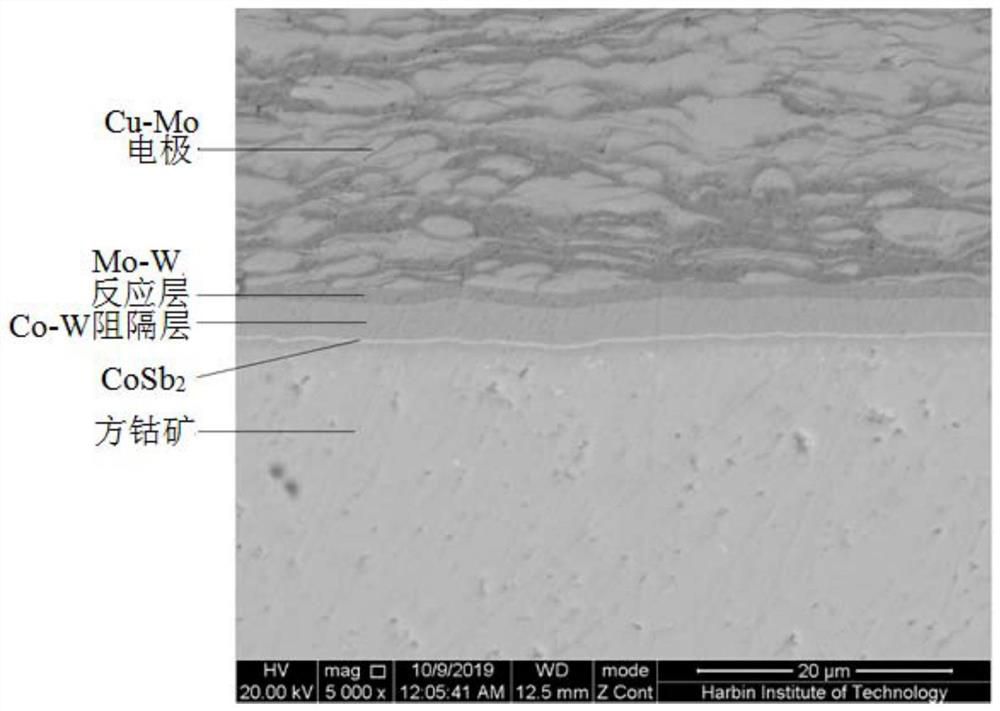A rapid diffusion welding connection method for skutterudite thermoelectric material and electrode
A technology of thermoelectric materials and connection methods, applied in welding equipment, non-electric welding equipment, welding/welding/cutting items, etc., can solve the problems of element volatilization, element diffusion, etc., achieve high strength, ensure contact resistivity, and high reliability Effect
- Summary
- Abstract
- Description
- Claims
- Application Information
AI Technical Summary
Problems solved by technology
Method used
Image
Examples
specific Embodiment approach 1
[0023] Specific embodiment one: this embodiment is used for the rapid diffusion welding connection method of skutterudite thermoelectric material and electrode is carried out according to the following steps:
[0024] Step 1. Take the electrode and clean the surface to be welded;
[0025] Step 2, electroplating an alloy barrier layer on the surface of the electrode to be welded after the treatment in step 1;
[0026] The temperature of the electroplating is 40-65°C, the current is 0.5-1.5A, and the time is 15-120min;
[0027] Step 3, the surface of the skutterudite thermoelectric material to be welded is cleaned;
[0028] Step 4. Stack the electrode obtained in step 2 and the skutterudite thermoelectric material. The alloy barrier layer of the electrode faces the surface of the skutterudite thermoelectric material to be welded to form a weldment, perform diffusion welding, and cool down to room temperature after diffusion welding, that is Finish;
[0029] The process of dif...
specific Embodiment approach 2
[0034] Specific embodiment 2: The difference between this embodiment and specific embodiment 1 is that the method for cleaning the surface of the electrode to be welded in step 1 is: successively use No. 600, No. 1000, No. 2000, No. 3000, and No. 5000 water abrasive paper to polish step by step The surface of the electrode to be welded is then polished, and finally ultrasonically cleaned; the cleaning of the electrode to be welded can remove the oxide film and oil. Other steps and parameters are the same as those in the first embodiment.
specific Embodiment approach 3
[0035] Embodiment 3: The difference between this embodiment and Embodiment 1 or 2 is that the electrode in step 1 is a copper-based electrode; the material of the copper-based electrode is Cu-Mo alloy, Cu-W alloy, Cu-Mo alloy, Cu-Cr alloy, Cu-V alloy, Cu-Ni alloy, Cu-A1 alloy or pure Cu, etc. Other steps and parameters are the same as those in Embodiment 1 or 2.
PUM
| Property | Measurement | Unit |
|---|---|---|
| thickness | aaaaa | aaaaa |
| strength | aaaaa | aaaaa |
| thickness | aaaaa | aaaaa |
Abstract
Description
Claims
Application Information
 Login to View More
Login to View More - R&D
- Intellectual Property
- Life Sciences
- Materials
- Tech Scout
- Unparalleled Data Quality
- Higher Quality Content
- 60% Fewer Hallucinations
Browse by: Latest US Patents, China's latest patents, Technical Efficacy Thesaurus, Application Domain, Technology Topic, Popular Technical Reports.
© 2025 PatSnap. All rights reserved.Legal|Privacy policy|Modern Slavery Act Transparency Statement|Sitemap|About US| Contact US: help@patsnap.com



